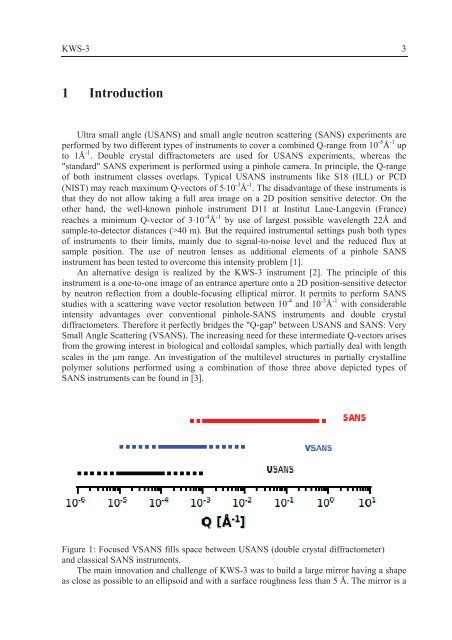Neutron Scattering - JUWEL - Forschungszentrum Jülich
Neutron Scattering - JUWEL - Forschungszentrum Jülich
Neutron Scattering - JUWEL - Forschungszentrum Jülich
You also want an ePaper? Increase the reach of your titles
YUMPU automatically turns print PDFs into web optimized ePapers that Google loves.
KWS-3 3<br />
1 Introduction<br />
Ultra small angle (USANS) and small angle neutron scattering (SANS) experiments are<br />
performed by two different types of instruments to cover a combined Q-range from 10 -5 Å -1 up<br />
to 1Å -1 . Double crystal diffractometers are used for USANS experiments, whereas the<br />
"standard" SANS experiment is performed using a pinhole camera. In principle, the Q-range<br />
of both instrument classes overlaps. Typical USANS instruments like S18 (ILL) or PCD<br />
(NIST) may reach maximum Q-vectors of 5�10 -3 Å -1 . The disadvantage of these instruments is<br />
that they do not allow taking a full area image on a 2D position sensitive detector. On the<br />
other hand, the well-known pinhole instrument D11 at Institut Laue-Langevin (France)<br />
reaches a minimum Q-vector of 3�10 -4 Å -1 by use of largest possible wavelength 22Å and<br />
sample-to-detector distances (>40 m). But the required instrumental settings push both types<br />
of instruments to their limits, mainly due to signal-to-noise level and the reduced flux at<br />
sample position. The use of neutron lenses as additional elements of a pinhole SANS<br />
instrument has been tested to overcome this intensity problem [1].<br />
An alternative design is realized by the KWS-3 instrument [2]. The principle of this<br />
instrument is a one-to-one image of an entrance aperture onto a 2D position-sensitive detector<br />
by neutron reflection from a double-focusing elliptical mirror. It permits to perform SANS<br />
studies with a scattering wave vector resolution between 10 -4 and 10 -3 Å -1 with considerable<br />
intensity advantages over conventional pinhole-SANS instruments and double crystal<br />
diffractometers. Therefore it perfectly bridges the "Q-gap" between USANS and SANS: Very<br />
Small Angle <strong>Scattering</strong> (VSANS). The increasing need for these intermediate Q-vectors arises<br />
from the growing interest in biological and colloidal samples, which partially deal with length<br />
scales in the �m range. An investigation of the multilevel structures in partially crystalline<br />
polymer solutions performed using a combination of those three above depicted types of<br />
SANS instruments can be found in [3].<br />
Figure 1: Focused VSANS fills space between USANS (double crystal diffractometer)<br />
and classical SANS instruments.<br />
The main innovation and challenge of KWS-3 was to build a large mirror having a shape<br />
as close as possible to an ellipsoid and with a surface roughness less than 5 Å. The mirror is a

















